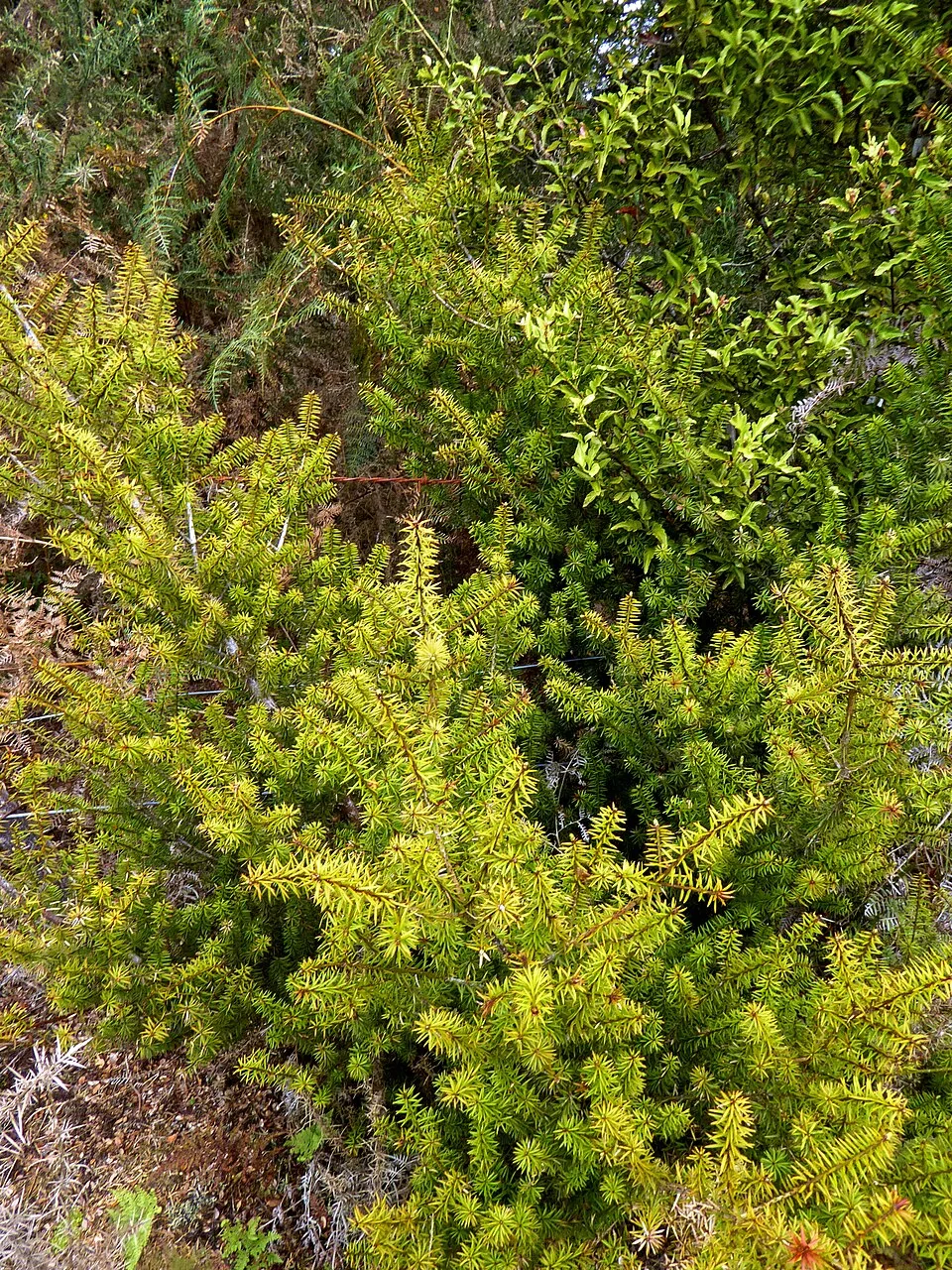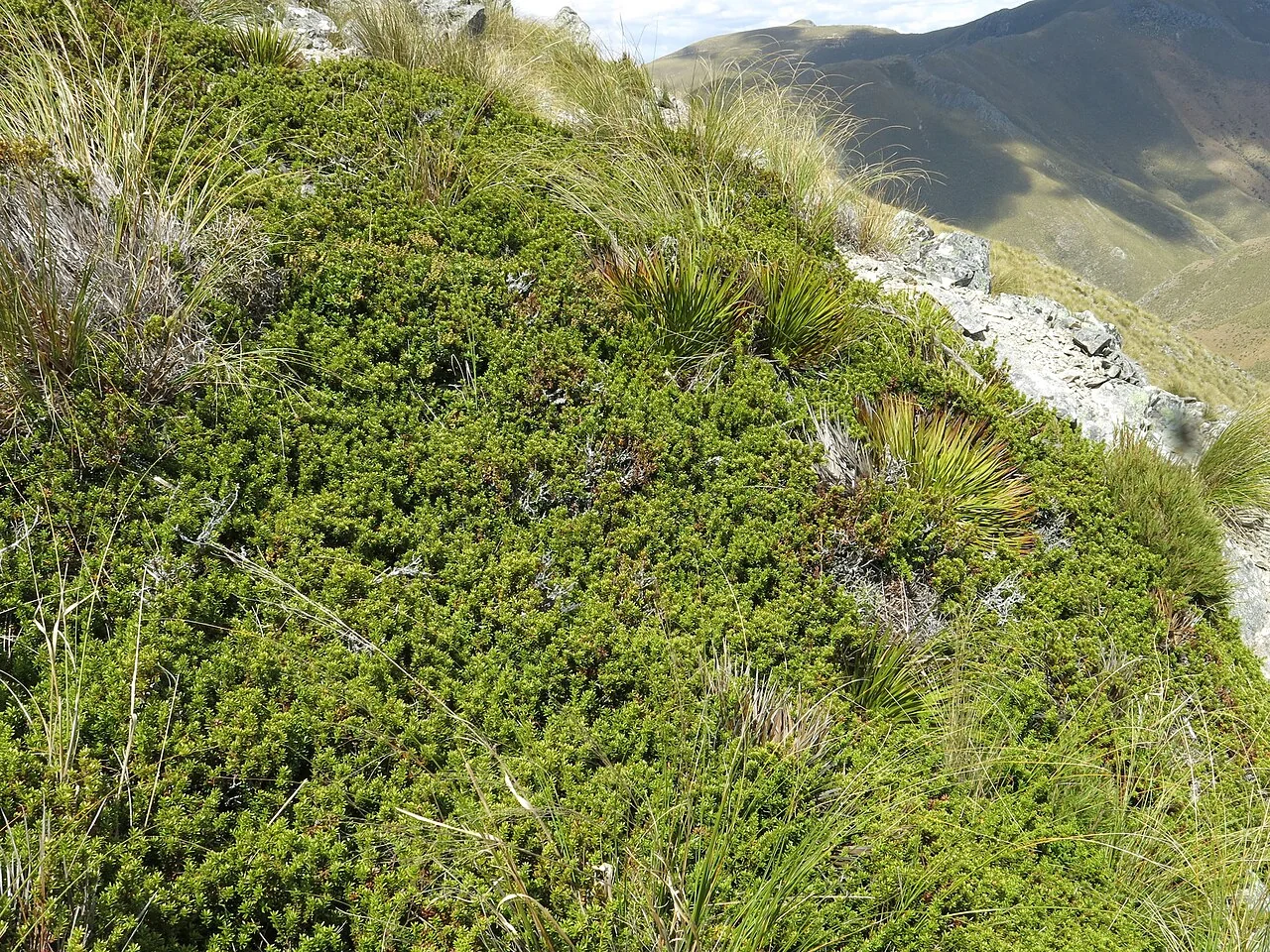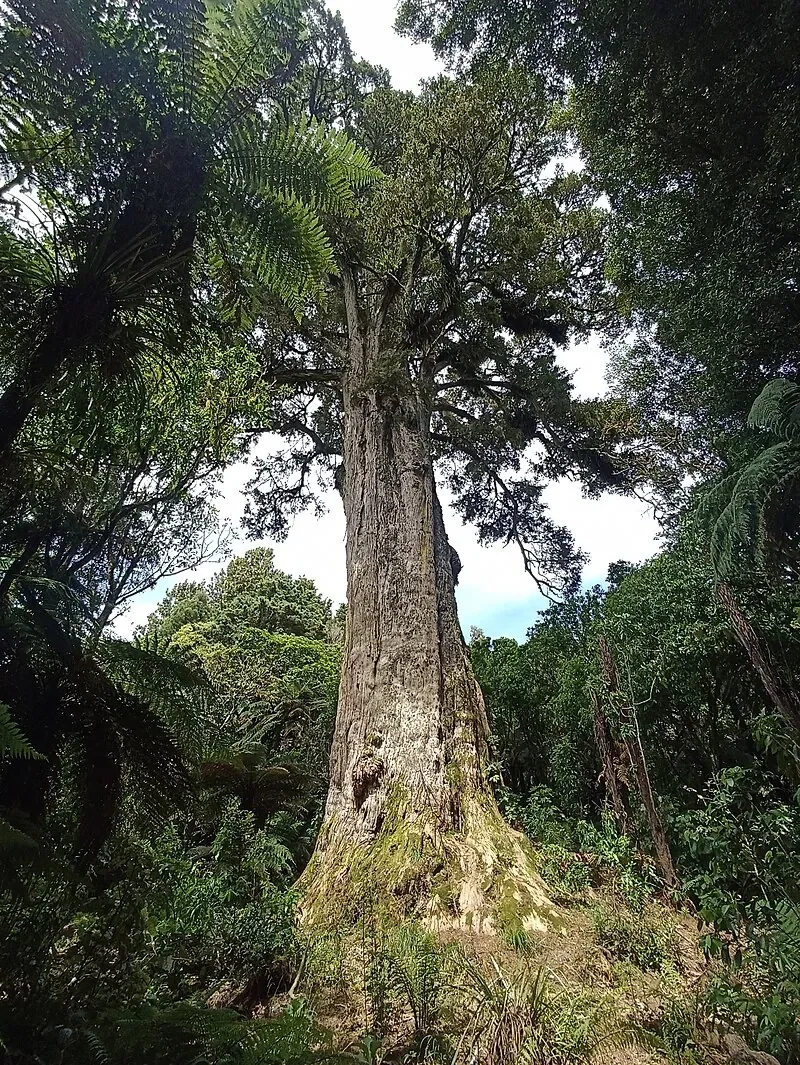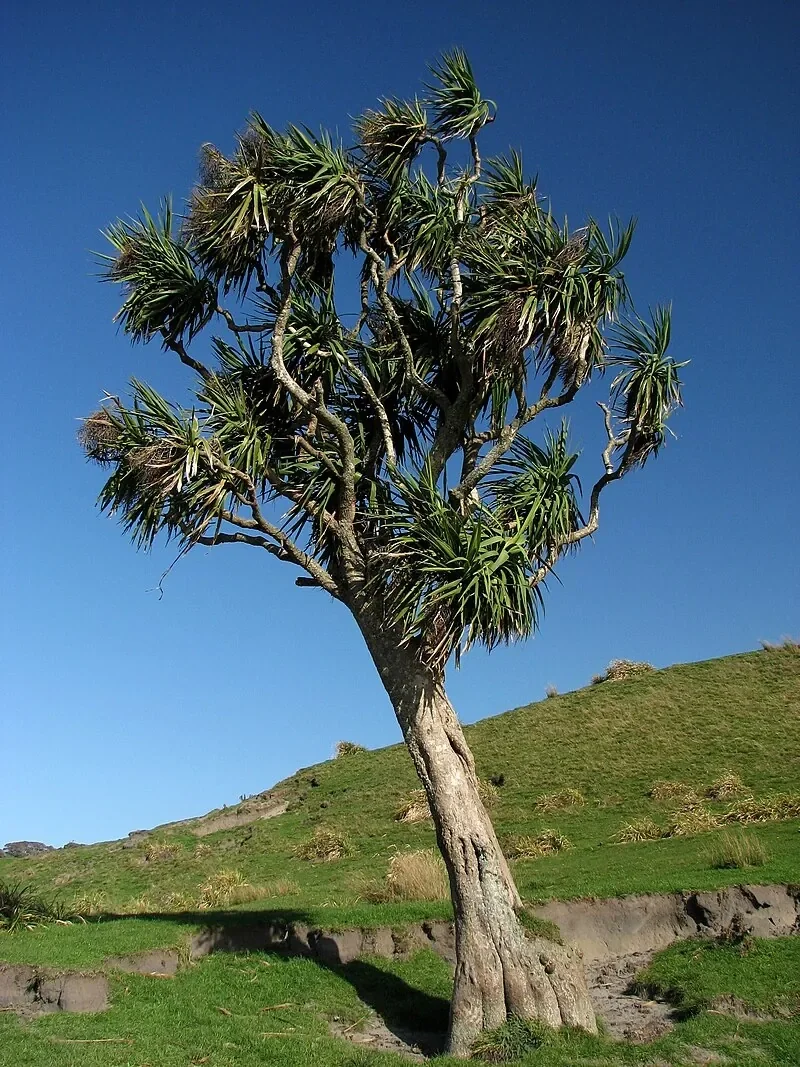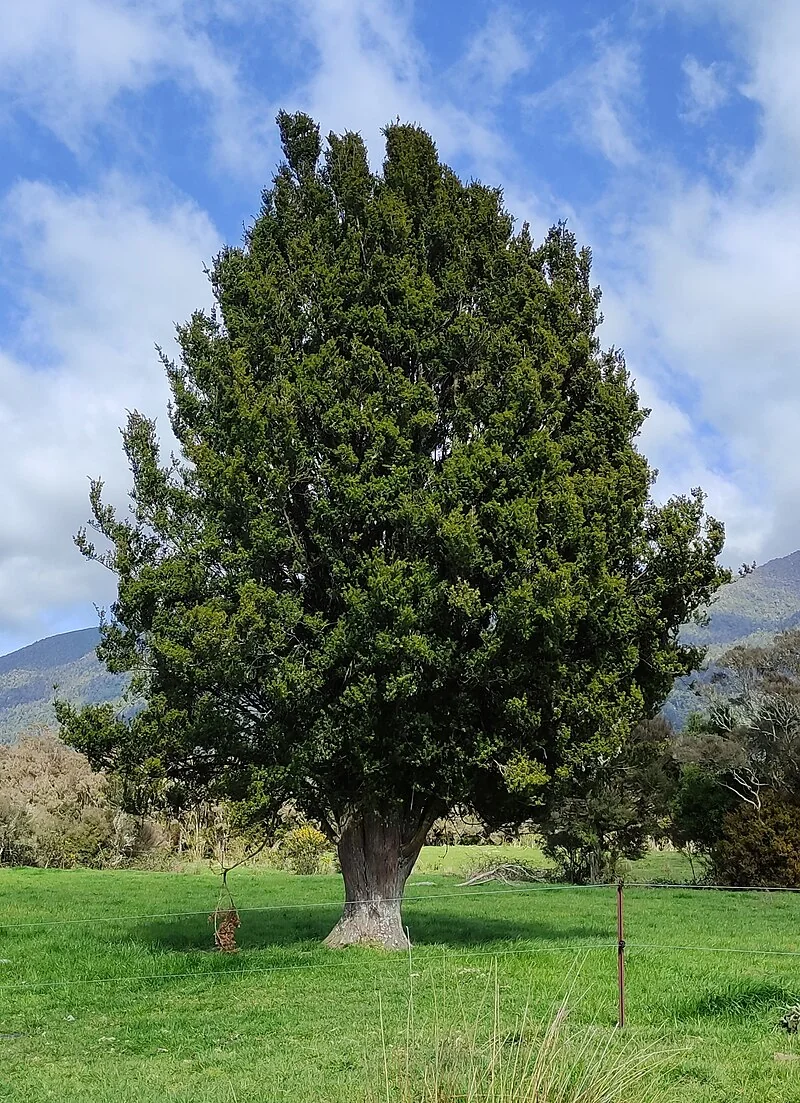
Mountain Tōtara
Podocarpus laetus
Mountain Tōtara is a hardy evergreen conifer reaching 6-15 meters tall, distinguished by its narrow, linear leaves and ability to thrive in harsh montane conditions up to 1200 meters elevation. This resilient species has distinctive copper-bronze bark and dense branching that creates excellent wind resistance. Endemic to New Zealand, it forms either a small to medium tree or large shrub depending on exposure, and produces bright red fruits that attract native birds. An excellent choice for challenging sites among New Zealand's native trees .

Plant Description
Botanical Features
Mountain Tōtara ( Podocarpus laetus ), also known as Hall's tōtara or thin-barked tōtara, is a species of conifer endemic to New Zealand. This evergreen tree can grow up to 20 meters tall with a stout trunk that can reach 125 cm in diameter. Its bark is notably thin, papery, and flaky, which distinguishes it from the more widely known lowland tōtara ( Podocarpus totara ). Juvenile trees often have slender, somewhat drooping branchlets. The leaves are brownish-green; juvenile foliage is linear-lanceolate, measuring 3-7 cm long by 3-5 mm wide, while adult leaves are smaller, 1.5-3 cm long by 3-4 mm wide, narrow-linear to linear-lanceolate, acute to acuminate, coriaceous, and pungent, typically with a visible midvein. It produces yellow-green catkins (pollen cones) that are 1-2.5 cm long, appearing in mid-spring to early summer. The ovules are solitary or paired, developing into seeds that are green, narrow-ovoid, pointed, and nut-like, often on red, swollen, and succulent receptacles. These attractive red fruits ripen in autumn and are a food source for native birds.
Quick Facts
Quick Facts Overview
| Scientific Name | Podocarpus Laetus |
|---|---|
| Height | 6-15 meters |
| Spread | 4-8 meters |
| Water Needs | Low to moderate |
| Light | Full sun to partial shade |
| Frost Tolerance | Very high (hardy to -15°C) |
| Salt Tolerance | Low to moderate |
| Growth Rate | Slow |
| Lifespan | 200-400 years |
Climate Best Suited to
Mountain Tōtara thrives in montane climates from 300-1200 meters elevation, where it experiences cool temperatures, moderate rainfall, and occasional snow. This hardy species tolerates extreme wind exposure and temperature fluctuations, making it ideal for challenging mountain conditions and exposed sites throughout New Zealand's cooler regions.
Regional Suitability
| Whangārei | Ideal |
| Auckland | Ideal |
| Hamilton | Suitable |
| Rotorua | Suitable |
| Tauranga | Ideal |
| Gisborne | Ideal |
| New Plymouth | Ideal |
| Whanganui | Ideal |
| Palmerston North | Suitable |
| Napier | Ideal |
| Wellington | Ideal |
| Nelson | Ideal |
| Christchurch | Suitable |
| Dunedin | Suitable |
| Invercargill | Suitable |
| City | Climate Suitability |
|---|
Plant Habitat
Plant Habitat Overview
The genus occupies habitats from sea level to treeline across New Zealand, with different species specialized for specific elevational and climatic zones. Tōtara thrives in lowland to montane forests on a variety of soil types, while alpine species like P. nivalis adapt to harsh mountain conditions with extreme temperature fluctuations and snow cover. Most species prefer areas with reliable moisture but good drainage.
Plant Conservation
Conservation
Podocarpus laetus , also known as Hall's tōtara, mountain tōtara, or thin-barked tōtara, is a conifer species endemic to New Zealand. It is found in montane and subalpine forests, typically at elevations between 300 and 1200 meters, and can tolerate harsh conditions like strong winds, cold temperatures, and drought. Despite historical exploitation for timber by Māori and early settlers, Podocarpus laetus is currently classified as "Least Concern" by the IUCN Red List of Threatened Species, a status maintained in assessments from 2013 to 2024. This is largely due to its extensive range and greater altitudinal distribution, which has ensured its survival over a sufficiently large area. Legal protections against logging native trees in New Zealand have also significantly reduced its exploitation. As a keystone species, Podocarpus laetus plays a vital role in New Zealand's forest ecosystems, supporting diverse communities of epiphytes, birds, and invertebrates. Its cone-fruits provide a crucial food source for native birds, which in turn help disperse its seeds. The species also contributes to carbon sequestration and forest structural complexity. While the species itself is not currently threatened, broader conservation challenges for Podocarpus species in New Zealand include limited regeneration due to deer browsing and competition from invasive species. Conservation efforts focus on protecting remaining mature forests and facilitating natural regeneration in appropriate habitats.
Growing Requirements
Soil Requirements
Mountain Tōtara adapts well to challenging soil conditions:
- Well-drained soils essential - excellent tolerance for poor soils
- Thrives in rocky, gravelly, or shallow soils over bedrock
- Cannot tolerate waterlogged or consistently wet conditions
- Suitable for slightly acidic to neutral pH (6.0-7.5)
- Performs well on slopes and ridges with good drainage
Light Requirements
Mountain Tōtara excels in exposed, sunny conditions:
- Full sun preferred for dense, compact growth
- Exceptional tolerance for wind exposure and high UV
- Can handle extreme weather once established
- Partial shade acceptable but may result in more open form
Water Requirements
Mountain Tōtara has low water requirements once established:
- Regular watering during establishment (first 2-3 years)
- Excellent drought tolerance once established
- Natural rainfall usually sufficient in most NZ locations
- Avoid overwatering which can promote disease
- Benefits from winter moisture but tolerates summer drought
Planting Guide
When to Plant
Plant Mountain Tōtara during autumn or early spring when temperatures are cool and soil moisture is adequate. This hardy species establishes well when planted during optimal weather conditions.
Site Selection
Choose a site with:
- Full sun exposure with excellent drainage
- Sloping or elevated position that avoids water accumulation
- Room for mature size (15 m tall, 8 m spread)
- Exposure tolerance once established makes windy sites acceptable
Planting Procedure
- Dig hole 2-3 times wider than root ball, same depth
- Improve heavy soils with sand and gravel for drainage
- Position tree so root collar sits at natural soil level
- Backfill with improved soil mixture
- Water thoroughly to settle soil around roots
- Create shallow watering basin for establishment
- Apply organic mulch but keep clear of trunk
Initial Care
Provide regular watering during first 2-3 years until established. Mountain Tōtara becomes quite drought-tolerant and low-maintenance once mature root system develops.
Ecological Role
Environmental Impact
Podocarpus species serve as keystone species in New Zealand's forest ecosystems, often forming emergent canopy layers that support diverse communities of epiphytes, birds, and invertebrates. Their modified cone-fruits provide crucial food resources for native birds like bellbird, tūī, and kākā, which in turn disperse seeds throughout the forest. As large biomass dominants, they play vital roles in carbon sequestration and forest structural complexity.
Uses Section
Uses Section Overview
This versatile native plant offers multiple practical applications in landscaping and garden design, from providing ground cover and erosion control to creating habitat for native wildlife. The plant 's natural characteristics make it valuable for restoration projects and sustainable gardening practices.
Cultural Significance
Cultural Importance
Tōtara Group Heritage
Mountain tōtara is part of the tōtara complex renowned for durable timber in traditional and colonial use. In montane forests it contributes to podocarp identity and long-lived canopy structure.
Podocarpus laetus , also known as montane totara, Hall's tōtara, or thin-barked tōtara, holds cultural significance primarily among the Māori people of New Zealand, and also had uses for early European settlers. The bark of Podocarpus laetus was historically used by southern Māori to create containers called "pohatiti" for storing muttonbirds. The Whanganui Māori also favoured tōtara k tukutuku (a Māori name for Podocarpus laetus ) for canoe making because its wood was not as straight-grained and free-splitting as other timbers. Like its close relative Podocarpus totara , Podocarpus laetus wood was valued by both Māori and early European settlers for construction, including houses, fence posts, and railway sleepers. The tōtara (which includes Podocarpus laetus ) is considered a sacred tree in Māori tradition. Its widespread growth across the country and its use in crafting large war canoes (taua) contributed to its esteemed status. Podocarpus laetus was likely the first New Zealand species to be used in dendrochronological research, specifically in an investigation of Māori archaeology.
Landscaping Section
Landscaping Section Overview
This section provides important information about plant care and cultivation practices. Understanding these aspects helps ensure successful growth and development in garden conditions.
Seasonal Care Calendar
Spring
- New growth begins with bronze-tinted young foliage
- Optimal time for planting in mountain conditions
- Begin watering schedule for newly planted trees
- Check for winter wind or snow damage
Summer
- Active growing period with excellent heat tolerance
- Male trees produce pollen, females develop seed cones
- Minimal watering needed except for young trees
- Excellent performance during hot, dry summers
Autumn
- Bright red fruits ripen on female trees, highly attractive to birds
- Excellent time for planting before winter
- Collect fresh seeds for propagation
- Natural leaf drop occurs as part of growth cycle
Winter
- Outstanding cold tolerance with no protection required
- Growth slows during coldest periods
- Fruits may persist providing winter food for wildlife
- Ideal time for any necessary pruning
When to Prune and How Much
When to Prune and How Much Overview
Mountain Tōtara develops naturally good structure requiring minimal pruning:
- Remove dead , diseased, or damaged branches any time of year
- Light structural pruning for young trees if multiple leaders develop
- Avoid heavy pruning as natural form is typically most attractive
- Late winter best timing for any structural work
- Dense branching rarely requires thinning
Use sharp , clean tools and make cuts just outside the branch collar. Mountain Tōtara has moderate wound response, so minimize unnecessary cuts.
How to Grow Mountain Tōtara
Mountain Tōtara ( Podocarpus laetus ) is a cold-tolerant tōtara of upland forests that performs best in cool, well-drained sites. This hardy evergreen conifer is a significant component of New Zealand's montane ecosystems, often found at elevations where other trees struggle. Its ability to withstand harsh conditions, including strong winds, cold temperatures, and occasional snow, makes it a valuable species for ecological restoration and challenging garden environments. While it is a slow-growing tree, its longevity and robust nature make it a rewarding plant to cultivate. Understanding its propagation methods is key to successfully establishing this resilient native.
From Seed
Propagating Mountain Tōtara from fresh seed is the most reliable method. Collect ripe arils (the fleshy, seed-bearing structures) when they are fully coloured and soft, typically in late summer to autumn. It is crucial to remove all fleshy tissue from the seeds, as this can inhibit germination. Rinse the seeds thoroughly and sow them promptly, as fresh, clean seed gives the best results. Use a free-draining, sterile seed-raising mix, such as a blend of sand and fine bark. Sow the seeds at a depth approximately equal to the seed's diameter and keep the medium evenly moist in bright, indirect light. Cool to mild temperatures (around 12-18 °C) suit germination, which can be slow and irregular, often taking several weeks to months. Once seedlings have developed a few true leaves and their root systems are secure, carefully prick them out into individual small pots, minimizing disturbance. Grow them on in light shade with steady moisture before gradually hardening them off.
From Juvenile Cuttings
Vegetative propagation of Mountain Tōtara from cuttings can be challenging, with success rates often variable. Short juvenile cuttings (6-10 cm) taken from non-flowering shoots in late summer to early autumn offer the best chance of success. Remove the lower leaves, lightly wound the base of the cutting, and treat it with a suitable IBA (Indole-3-butyric acid) rooting hormone to stimulate root development. Insert the cuttings into a very free-draining medium, such as coarse perlite with fine bark, under high humidity and gentle bottom heat (around 18-22 °C) in bright, filtered light. Rooting is slow and variable, often taking several months. Pot on only once a firm root system has formed, and then gradually wean the new plants from high humidity. This method is generally more successful for experienced propagators or in specialized nursery settings.
Pests and Diseases
Scale Insects
- Damage: Various scale species may infest foliage and branches
- Symptoms: Yellowing needles , sticky honeydew, reduced vigor
- Management: Usually not serious; horticultural oil if severe; maintain tree health
Root Rot Diseases
- Cause: Poor drainage leading to waterlogged root zones
- Symptoms: Yellowing foliage , branch dieback, overall decline
- Management: Ensure excellent drainage; avoid overwatering; improve soil structure
Wind and Weather Damage
- Ice damage : Heavy ice loads can break branches
- Wind damage : Young trees may suffer from extreme exposure
- Management: Provide temporary shelter during establishment; prune damaged growth
Browsing Damage
- Deer and goats: May browse on foliage in mountain areas
- Possums: Can damage bark and foliage
- Management: Install tree guards; control browsing animals
Mountain Tōtara's natural hardiness means most problems arise from unsuitable growing conditions rather than pests or diseases. Focus on proper site selection and drainage.
Bonus Tip
Expert Growing Advice
Mountain Tōtara ( Podocarpus laetus ) was previously known as Podocarpus hallii , and is closely related to the more common lowland tōtara ( Podocarpus totara ). It can be distinguished by its thinner, papery bark that flakes freely, unlike the thick, furrowed bark of P. totara . Additionally, its leaf buds are distinctly wider than the branchlets, a subtle but key identifying feature.
